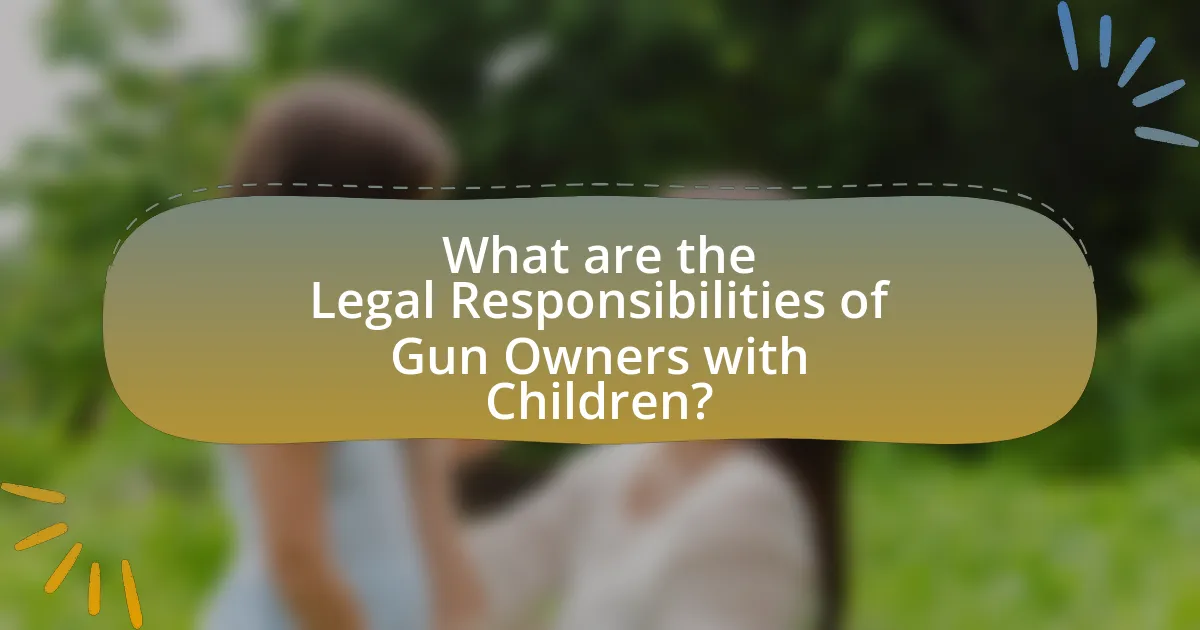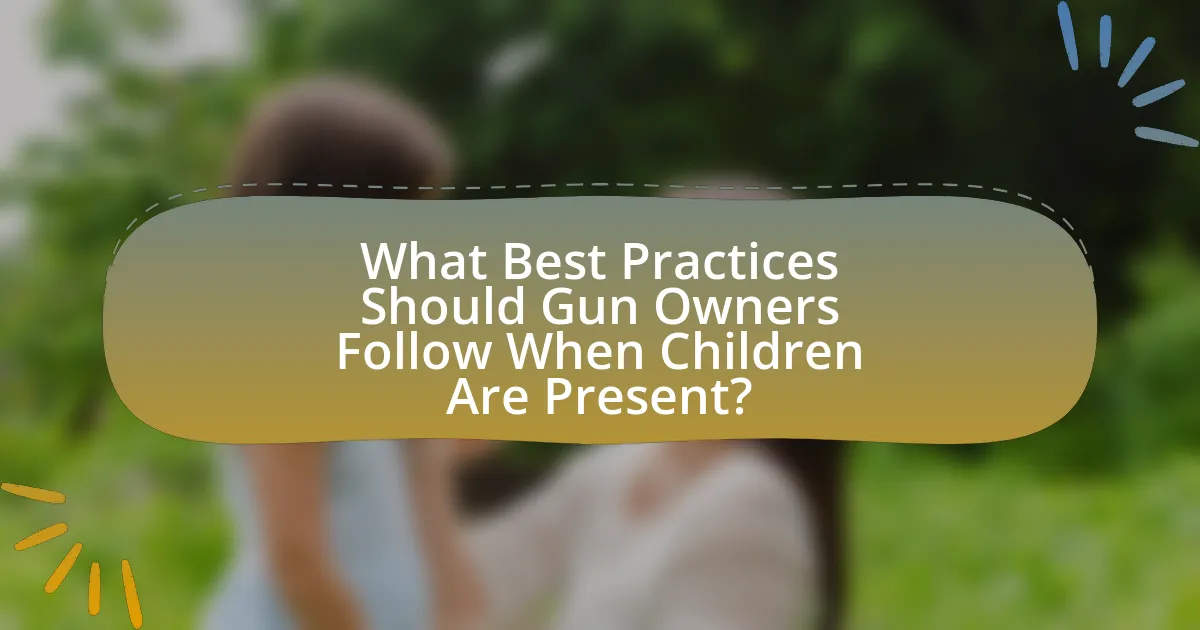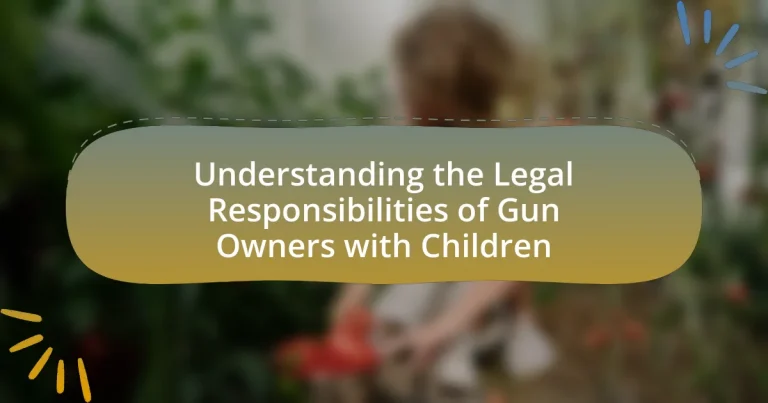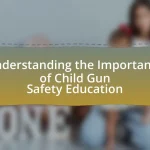The article focuses on the legal responsibilities of gun owners with children, emphasizing the necessity for secure firearm storage to prevent unauthorized access by minors. It outlines specific laws, such as Child Access Prevention (CAP) laws, that mandate safe storage practices and the potential legal consequences for non-compliance, including criminal charges and civil liability. The article also discusses the importance of education and communication about firearm safety within families, highlighting best practices for responsible gun ownership and the resources available for gun owners to stay informed about safety and legal obligations. Additionally, it addresses common misconceptions about gun ownership and children, reinforcing the need for accurate information to promote safety and prevent accidents.

What are the Legal Responsibilities of Gun Owners with Children?
Gun owners with children have a legal responsibility to ensure that firearms are stored securely and inaccessible to minors. This often includes using gun safes, locks, or other safety devices to prevent unauthorized access. Many states have specific laws mandating safe storage practices, which can include penalties for non-compliance. For example, in California, the law requires that firearms be stored in a locked container or disabled with a locking device if a child is likely to gain access. Failure to adhere to these regulations can result in criminal charges or civil liability if a child gains access to a firearm and causes harm.
Why is it important for gun owners to understand their legal responsibilities?
It is important for gun owners to understand their legal responsibilities to ensure safe and lawful firearm ownership and usage. Understanding these responsibilities helps prevent legal repercussions, such as criminal charges or civil liability, which can arise from improper handling or storage of firearms. For instance, in many jurisdictions, gun owners are legally required to secure firearms to prevent access by children, and failure to comply can result in severe penalties, including fines or imprisonment. Additionally, knowledge of laws regarding the use of firearms in self-defense or during hunting can protect gun owners from legal disputes. Therefore, being informed about legal obligations not only promotes safety but also safeguards gun owners from potential legal consequences.
What laws govern gun ownership in relation to children?
Laws governing gun ownership in relation to children primarily focus on safe storage requirements and restrictions on access. The Child Access Prevention (CAP) laws in various states mandate that gun owners securely store firearms to prevent children from accessing them. For instance, in states like California and Massachusetts, parents can face criminal charges if a child gains access to an unsecured firearm. Additionally, federal law prohibits the sale of firearms to individuals under 18, ensuring that children cannot legally possess guns. These regulations aim to reduce accidental shootings and promote responsible gun ownership among families.
How do these laws vary by state or region?
Gun laws regarding the responsibilities of owners with children vary significantly by state and region. For instance, some states, like California, have strict safe storage laws requiring firearms to be locked away when not in use, especially if children are present, while other states, such as Texas, have more lenient regulations that do not mandate such storage. Additionally, states like Florida impose criminal penalties for failing to secure firearms from children, whereas states like Montana may not have specific laws addressing this issue. These variations reflect differing regional attitudes towards gun ownership and child safety, influencing how legal responsibilities are defined and enforced across the United States.
What are the potential consequences of failing to meet these responsibilities?
Failing to meet the legal responsibilities of gun ownership with children can lead to severe consequences, including criminal charges, civil liability, and increased risk of accidents. Criminal charges may arise from negligence or failure to secure firearms, potentially resulting in fines or imprisonment, as seen in cases where gun owners face charges for child endangerment. Civil liability can occur if a child accesses a firearm and causes harm, leading to lawsuits against the owner for damages, which can be financially devastating. Additionally, the presence of unsecured firearms increases the likelihood of accidental shootings, with statistics indicating that over 300 children die annually in the U.S. from unintentional firearm injuries. These consequences underscore the critical importance of adhering to legal responsibilities as a gun owner, especially in households with children.
What legal actions can be taken against negligent gun owners?
Negligent gun owners can face criminal charges, civil liability, and administrative penalties. Criminal charges may include reckless endangerment or unlawful discharge of a firearm, which can lead to fines or imprisonment. Civil liability allows victims or their families to sue for damages resulting from negligence, such as injuries or wrongful death. Administrative penalties may involve the revocation of gun permits or licenses. These actions are supported by laws in various jurisdictions that hold gun owners accountable for failing to secure firearms, particularly in households with children, thereby reinforcing the legal responsibilities of gun owners.
How can negligence impact child safety and well-being?
Negligence can significantly compromise child safety and well-being by exposing children to preventable risks and hazards. For instance, when gun owners fail to secure firearms properly, children may gain unauthorized access, leading to accidental injuries or fatalities. According to the Centers for Disease Control and Prevention (CDC), unintentional firearm injuries are a leading cause of death among children, highlighting the critical need for responsible gun ownership. Furthermore, negligence in supervision or safety measures can result in emotional and psychological harm, as children may experience trauma from witnessing violence or accidents. Thus, the legal responsibilities of gun owners directly correlate with the safety and well-being of children in their environment.

How can Gun Owners Safeguard Children from Firearm Risks?
Gun owners can safeguard children from firearm risks by securely storing firearms in locked cabinets or safes and using trigger locks. Secure storage prevents unauthorized access, significantly reducing the likelihood of accidental shootings; studies indicate that proper storage can decrease firearm-related accidents among children by up to 73%. Additionally, educating children about gun safety and the dangers of firearms fosters awareness and responsibility. The National Safety Council emphasizes that teaching children to recognize and avoid firearms can further mitigate risks.
What safety measures should gun owners implement in homes with children?
Gun owners should implement strict safety measures such as securely storing firearms in locked safes or cabinets, using trigger locks, and ensuring that ammunition is stored separately from firearms. These measures significantly reduce the risk of accidental shootings involving children, as studies indicate that approximately 1,300 children die each year from gun-related incidents in the United States, often due to unsecured firearms. Additionally, educating children about gun safety and the importance of not touching firearms without adult supervision further enhances safety in homes with children.
How can secure storage solutions prevent unauthorized access?
Secure storage solutions prevent unauthorized access by employing mechanisms such as locks, biometric systems, and secure containers designed to restrict access to firearms. These solutions ensure that only authorized individuals, such as the gun owner, can access the stored weapons, thereby reducing the risk of accidental use or theft, particularly by children. For instance, the use of gun safes that meet the standards set by the American National Standards Institute (ANSI) can significantly lower the likelihood of unauthorized access, as these safes are designed to withstand tampering and forced entry. Additionally, statistics indicate that homes with secure storage practices experience a 43% reduction in firearm-related accidents involving children, highlighting the effectiveness of these solutions in promoting safety.
What role does education play in promoting firearm safety among children?
Education plays a crucial role in promoting firearm safety among children by equipping them with knowledge about the dangers of firearms and safe handling practices. Through structured programs, children learn to recognize firearms, understand the importance of not touching them, and know to seek help from an adult if they encounter a gun. Research indicates that educational interventions, such as the Eddie Eagle GunSafe Program, have effectively reduced the likelihood of unintentional firearm injuries among children by teaching them critical safety messages. This evidence underscores the importance of education in fostering a culture of safety and responsibility regarding firearms in households with children.
What resources are available for gun owners to learn about safety and legal responsibilities?
Gun owners can access various resources to learn about safety and legal responsibilities, including the National Rifle Association (NRA), which offers training courses and educational materials focused on firearm safety and laws. Additionally, the Bureau of Alcohol, Tobacco, Firearms and Explosives (ATF) provides comprehensive guides on federal firearms regulations and safety practices. State-specific resources, such as local law enforcement agencies and state firearm associations, also offer information tailored to regional laws and safety protocols. These organizations are recognized for their commitment to promoting responsible gun ownership and ensuring compliance with legal standards.
Which organizations provide training and information on gun safety?
Organizations that provide training and information on gun safety include the National Rifle Association (NRA), the National Shooting Sports Foundation (NSSF), and the American Academy of Pediatrics (AAP). The NRA offers various courses on firearm safety and responsible ownership, while the NSSF focuses on promoting safe and responsible shooting practices through education and outreach. The AAP provides resources aimed at educating parents about gun safety in homes with children, emphasizing the importance of secure storage and safe handling practices. These organizations are recognized for their commitment to enhancing gun safety awareness and education.
How can gun owners stay updated on changing laws and regulations?
Gun owners can stay updated on changing laws and regulations by regularly consulting official government websites, subscribing to legal newsletters, and following reputable organizations focused on gun rights and safety. Official government websites, such as state legislatures and the Bureau of Alcohol, Tobacco, Firearms and Explosives, provide the most accurate and current legal information. Legal newsletters from organizations like the National Rifle Association or the Second Amendment Foundation offer insights into legislative changes and court rulings. Additionally, engaging with local gun clubs or advocacy groups can provide community-specific updates and discussions on relevant legal matters.

What Best Practices Should Gun Owners Follow When Children Are Present?
Gun owners should always store firearms securely and out of reach of children to prevent accidental access. This includes using locked safes, gun cabinets, or trigger locks, which are proven methods to reduce the risk of unintentional shootings among minors. According to the Centers for Disease Control and Prevention (CDC), safe storage practices can significantly decrease the likelihood of firearm-related injuries in children. Additionally, gun owners should educate children about the dangers of firearms, emphasizing that they should never touch a gun without adult supervision. This proactive approach, combined with secure storage, aligns with best practices for responsible gun ownership when children are present.
How can gun owners effectively communicate about firearm safety with children?
Gun owners can effectively communicate about firearm safety with children by using clear, age-appropriate language and engaging in open discussions about the dangers of firearms. This approach fosters understanding and encourages children to ask questions. Research indicates that children who receive proper education about firearm safety are less likely to engage in unsafe behaviors around guns. For instance, a study published in the Journal of Pediatrics found that children who participated in firearm safety programs demonstrated improved knowledge and safer attitudes towards guns. By consistently reinforcing safety rules, such as treating every gun as if it is loaded and never touching a firearm without adult supervision, gun owners can instill responsible behaviors in children.
What age-appropriate discussions should be had regarding firearms?
Age-appropriate discussions regarding firearms should include safety, responsibility, and the legal implications of gun ownership. For young children, conversations should focus on the importance of not touching firearms and informing an adult if they encounter one. As children grow older, discussions can expand to include the responsibilities of gun ownership, such as safe storage practices and the legal consequences of mishandling firearms. By age 12, children should understand the laws surrounding firearms in their state, including age restrictions and the importance of following safety protocols. Research indicates that early education on firearm safety can significantly reduce accidental shootings among children, highlighting the necessity of these discussions.
How can parents model responsible behavior around firearms?
Parents can model responsible behavior around firearms by demonstrating safe handling practices and emphasizing the importance of firearm education. For instance, parents should always treat firearms as if they are loaded, keep them secured in a locked safe, and ensure that children understand the dangers associated with guns. Research indicates that homes with locked firearms have a significantly lower risk of accidental shootings involving children, highlighting the effectiveness of secure storage. Additionally, engaging in open discussions about gun safety and the legal responsibilities of gun ownership reinforces the importance of responsible behavior.
What are common misconceptions about gun ownership and children?
Common misconceptions about gun ownership and children include the belief that simply owning a gun increases the risk of accidental injury to children, and that children cannot be taught to handle firearms safely. Research indicates that responsible gun ownership, including secure storage and education, significantly reduces the risk of accidents. For example, a study published in the journal “Pediatrics” found that children who received firearm safety training were less likely to engage in unsafe behaviors around guns. Additionally, many assume that all children are inherently unsafe around firearms, but studies show that with proper education and supervision, children can learn to respect and handle guns safely.
How do myths about gun safety impact real-world practices?
Myths about gun safety significantly undermine real-world practices by fostering dangerous misconceptions among gun owners. For instance, the belief that a gun is always safe when unloaded can lead to negligent storage and handling, increasing the risk of accidental shootings, particularly involving children. Research from the American Academy of Pediatrics indicates that homes with firearms are three times more likely to experience unintentional firearm deaths among children compared to homes without guns. This highlights how myths can directly contribute to unsafe environments, emphasizing the need for accurate education on gun safety to mitigate risks and fulfill legal responsibilities as gun owners.
What facts should gun owners know to counter these misconceptions?
Gun owners should know that safe storage laws are in place to protect children from accidental firearm injuries. According to the Centers for Disease Control and Prevention (CDC), nearly 500 children die each year from unintentional firearm injuries, highlighting the importance of secure storage. Additionally, many states have enacted laws requiring gun owners to store firearms in a locked container or with a trigger lock when children are present, reinforcing the legal responsibility to prevent access. Furthermore, studies show that proper education about firearms significantly reduces the risk of accidents among children, emphasizing the need for gun owners to engage in safety training and discussions with their families.
What practical tips can gun owners implement to ensure safety?
Gun owners can implement several practical tips to ensure safety, particularly when children are present. First, secure firearms in a locked safe or cabinet to prevent unauthorized access, as studies show that 73% of unintentional firearm deaths among children occur in homes where guns are stored unlocked. Second, use trigger locks or cable locks on firearms to provide an additional layer of security. Third, educate children about gun safety, emphasizing that they should never touch a firearm without adult supervision. According to the National Shooting Sports Foundation, proper education can significantly reduce the risk of accidents. Lastly, regularly review and practice safety protocols with all household members to reinforce safe handling and storage practices.

